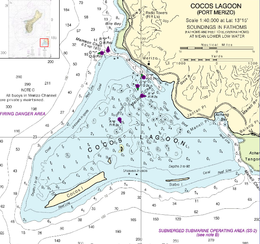Cocos Island (Guam)
 | |
 Nautical chart of Cocos Lagoon, with Cocos Island in the southwest (lower left) | |
| Geography | |
|---|---|
| Location | Pacific Ocean |
| Coordinates | 13°14′10″N144°38′56″E/ 13.23611°N 144.64889°E |
| Administration | |
| Additional information | |
| Time zone | |
Cocos Island(Chamorro:Islan Dåno) is an island 1 mile (1.6 km) off the southern tip of theUnited Statesterritory ofGuam,located within theMerizo Barrier Reef,part of themunicipalityofMalesso'.The island is uninhabited, 1,600 meters (5,200 ft) long in a southwest–northeast direction, between 200 m (660 ft) and 300 m (980 ft) wide, and has an area of 386,303 m2(95.458 acres).[1]It sits atop the southwesterncoralreefrim ofCocos Lagoon.
The east coast of the island is a day resort with a pool, volleyball court, cafe, ice cream parlor, restaurant and bar, and water sports equipment rentals. Visitors to the resort can snorkel, dive, kayak, dolphin watch, parasail, jet ski and bike. The west side is public land, part of the Territorial Park System. Ferries run to Malesso'.
During the Spanish times, the island was owned by Don Ignacio Mendiola Dela Cruz (Tu'an). In the late 1920s, the US Government acquired two thirds of the island viaeminent domain.In the mid-1930s, Don Ignacio sold the remaining third to a businessman named Gottwald. ACoast Guardlong-range navigation station was built and operated on Cocos Island from 1944 to 1963. In the late 80s to early 90s, the US Government. returned the larger portion of the island to the Guam Government, who then turned it into a park.
Military tests on soil from Cocos Island in late 2005 showed levels ofpolychlorinated biphenyls(PCBs) contamination 4,900 times higher than the federally recommended level. Tests on twelve species of fish in the lagoon showed all but one of those species had high levels of PCBs. One had 265 times the acceptable level. The contamination most likely originated from transformers and other electrical equipment at theCoast Guardstation,[citation needed]but was not tested for earlier.
Officials from theGuam Environmental Protection Agency,Guam Department of Public Health and Social Services,and the Coast Guard announced their findings on 20 February 2006 and warned people not to eat fish caught in the lagoon.[citation needed]
Cocos Island is one of the few locations to have had the endangeredGuam railreintroduced to it.[2]
On 5 November 2020, the US Department of the Interior and the US Geological Survey announced that thebrown tree snakehad been found on Cocos Island.[3]The brown tree snake is an invasive species responsible for the eradication of many species of wildlife native to Guam, including birds and lizards. It is thought to have arrived as a stowaway in cargo, and was first detected in the 1950s.[4]It causes millions of dollars in damage each year, most notably to the electrical system because it climbs the poles and shorts the wires.[5]
See also[edit]
Bibliography[edit]
- The Island of GuamBy Leonard Martin Cox[6]
References[edit]
- ^U.S. Census website
- ^"Endemic Guam Rail reintroduced onto Guam after two decades of extinction in the wild".Archived fromthe originalon 14 January 2011.Retrieved31 May2015.
- ^"Invasive Brown Treesnake Present on Cocos Island, Agencies Working to Prevent Further Spread".United States Geological Survey.Retrieved2 July2021.
- ^"Brown Tree Snake | National Invasive Species Information Center".invasivespeciesinfo.gov.Retrieved2 July2021.
- ^"Brown Tree Snake | National Invasive Species Information Center".invasivespeciesinfo.gov.Retrieved2 July2021.
- ^Martin Cox, Leonard (1917).The Island of Guam.Washington: Government Printing Office. p. 66.Retrieved13 January2020.
- Pacific Daily News article[permanent dead link]
- Bendure, G. & Friary, N. (1988)Micronesia:A travel survival kit.South Yarra, VIC: Lonely Planet.
